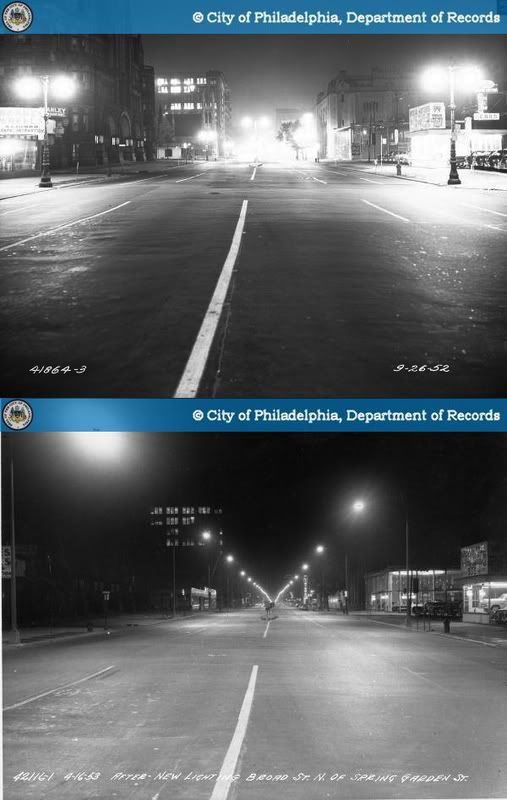Saturday, January 3, 2009
An old montage: North Broad Street north of Spring Garden, Philadelphia
Here's a before and after montage which I had no part in making, aside from a bit of photo-edited brightness correction. Taken on Broad Street north of Spring Garden, the two night photos show North Broad Street before and after the city replaced its existing street lights with the new type of fixture which has since become ubiquitous on America's streets, often called the Cobra-head light. Replicas of Broad Street's original electric street lights are still to be found on the Avenue of the Arts section of South Broad, and the Cobra-head lamps are of course still on most of North Broad Street.
It should be noted that night photography is tricky, and that its resulting photos can be slightly misleading. Nonetheless, this montage easily shows the essential fact that while Cobra-head lamps do a relatively good job of lighting the roadway, they are rather awful at lighting the sidewalk and surrounding buildings, which are barely visible in the bottom photo. I would definitely not be the first to discuss the importance of proper street lighting to pedestrian comfort and safety, so for that I would consult the archives of Philly Skyline for a great piece by contributor Nathaniel Popkin.
Though seen as nothing more than progress at the time, this replacement of street lights was in some respect the replacement of something distinctfully and gracefully Philadelphian with something banal, utilitarian, and placeless. More importantly, it reveals a planning culture that revered automobiles and highways at the expense of walking people and sidewalks. In fact, the reaction in recent decades against mid-century planning failures has been accompanied by the return of sidewalk-scaled lighting to many of America's downtowns, including most of Center City.
It's hard not to hold a somewhat morbid fascination with North Broad Street's violent decline from the grand promenade of North Philadelphia's nouveaux riches to the crumbling strip of vacant lots, gas stations, and drive-thru fast food outlets that we know today. Perhaps because of how tragic and swift that transition was, its breakdown into individual moments like these is somehow wondrous to see.
Original Photos: 1. Balionis, Francis, and Bender, Charles J. "Public Works-41864-3." 1952. Philadelphia City Archives. PhillyHistory.org. Philadelphia Department of Records. http://www.phillyhistory.org/PhotoArchive/MediaStream.ashx?mediaId=87703
2. Bender, Charles J. "Public Works-42116-1." 1953. Philadelphia City Archives. PhillyHistory.org. Philadelphia Department of Records. 3 Jan. 2009. http://www.phillyhistory.org/PhotoArchive/MediaStream.ashx?mediaId=38565
Subscribe to:
Post Comments (Atom)

No comments:
Post a Comment